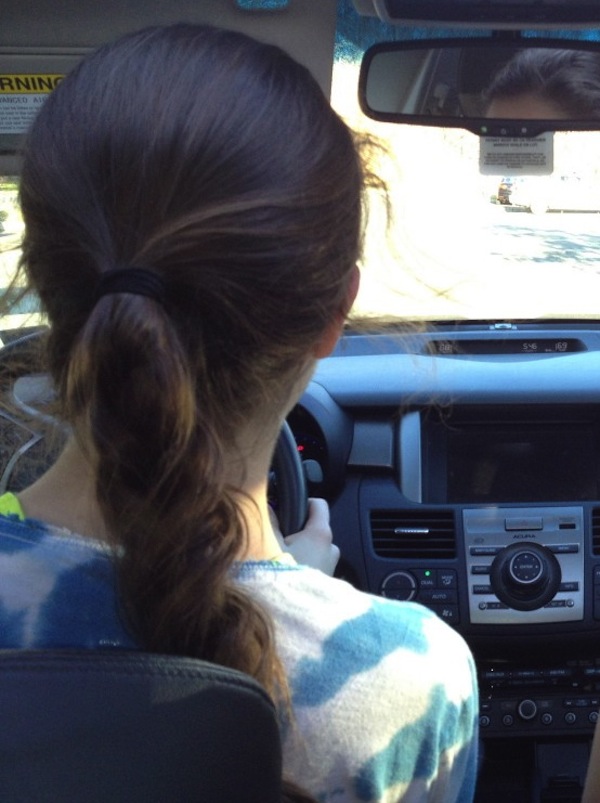
As we write this we are teaching our youngest children to drive. This is a path we have been down before, but as our impulse for self-preservation is undiminished, we still find it a bit frightening this last time. Learning to drive may be one of the great adolescent milestones but, for parents, it represents a major push back from our kids as they claim their independence from us. Truthfully, the whole process is driving us crazy.
Mary Dell is teaching a daughter and Lisa is teaching a son, so in effect we are living on different planets. The one thing we share is the deep scary realization that we are placing a lethal weapon in the hands of children we love, but who we know to be only part way on their journey to maturity.
The adolescent brain craves risk in a way that it never will again and it is at this moment that we climb into the car, our nervous, or perhaps worse, over-confident teen behind the wheel and we say, “Daddy will be really angry if you get us killed, so let’s take it a step at a time.”
Driving with a daughter:
This is round two for me as our college aged son learned to drive at the same school, with an almost identical car, and same parents. How could the results have been so different?
“Honey, you need to speed up a bit” is a direction I can swear to you I never gave to our son but have heard myself saying, somewhat incredulously, since our daughter passed her road test a month ago. Apparently, mastering the on-ramps of freeways is curriculum that Drivers’ Ed delegates to parents. Yikes!
Her cautious approach, while greatly appreciated by risk-averse parents, sometimes confuses other drivers. I try to explain that fellow travelers expect behavior that is not perfectly polite. Behind the wheel is a time to be a bit pushy.
Signs that there is a girl assuming possession of the family car? Hand sanitizer at the ready, multiple pair of sunglasses for accessorizing needs, pastel key fob dangling from the ignition. These greatly appeal to me, especially as the car was more of a traveling locker room when driven with son. Cleats, workout gear and multiple footballs infused the car with an incongruous scent of sweat and Axe body spray that endured even after our son left for college.
Driving with a son:
My youngest son is the fourth male in my family that I have helped learn to drive. My husband was by far the easiest. At 28 he had a full-blown sense of his mortality and of our impending child. But now I am teaching a 16 year son to drive and this is just a sampling of what I have heard this week:
“When you are not in the car I am not going to drive like this, slowing down smoothly and speeding up smoothly, I am just trying to keep you from getting car sick.”
“How hard can it be, there are only two pedals and a steering wheel?”
After I pointed out that the oncoming traffic has the right of way when making a left hand turn and you cannot gun it and cut in front of them as he had just done, “Okay, I’ll give you that…”
“I am ready for the highway…come on, I have had my permit for three days and I have driven at 30 and 40 MPH, I am ready for the big time.”
“There is no way I am letting him pass me, getting passed is for wimps”
While I might joke about this on the page, as a parent we all have very big concerns about this monumental step that our adolescents take. Is this just young male bravado, or do I have real reason to worry?
Teen males are at higher risk of motor vehicle crashes. According to the CDC, the motor vehicle death rate for male drivers and passengers ages 15 to 19 was almost two times that of females.
In New York state 16 ½ year olds who have obtained their junior license are allowed a single non-family member in the car with them. Nearby Connecticut allows no non-family members deeming them a distraction. The facts however are very interesting.
When a male passenger was in the car, 25% of drivers (male & female) exceeded the speed limit by 15 mph or more, versus about 6-7% of drivers doing this when there were no passengers or a female passenger.
Are we having the typical experience? Are boys really that much more daring and therefore a risk to themselves and others? Is their over confidence and fearlessness in the face of speed the huge danger that we think it is?
According to a 2012 study by the Children’s Hospital of Philadelphia Research Institute: With peer passengers in the car, male teen drivers were almost six times more likely to perform an illegal maneuver and twice more likely to act aggressively before crashing than when driving alone. Conversely, female teen drivers rarely drove aggressively before crashing, regardless of the presence of peer passengers
The scariest moment isn’t when you first get behind the wheel with your newly permitted teen, or the time you have to shout, “you were not looking, you did not see that.” but rather the moment you watch them drive away. For them it is an unprecedented taste of freedom, only akin to learning to walk in its powers to liberate, but for parents it is the beginning of an unprecedented period of worry, and it turns out with good reason.
This is not to say that female teen drivers do not still face very large crash risks. The crash risk for both male and female teen drivers is highest for the first six to twelve months after they get their GDL restricted license, when they can start driving without parents in the car.
Teaching Teens to Drive is Driving Me Crazy By Grown and Flown Parenting From the Empty Nest




























Comments
We are teaching our teenage
We are teaching our teenage son to drive and it is so frustrating sometimes. He acts as if it is just a video game!
I remember getting many
I remember getting many headaches when I was teaching my son to drive...